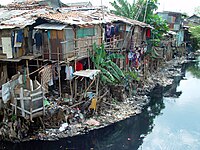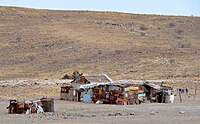Shack: Difference between revisions
No edit summary |
Cassiopeia (talk | contribs) m Reverted edits by John_smithinson (talk): not providing a reliable source (WP:CITE, WP:RS) (HG) (3.4.9) |
||
| Line 5: | Line 5: | ||
A '''shack''' (or, less often, '''shanty''') is a type of small, often primitive shelter or dwelling. Like [[hut]]s, shacks are constructed by hand using available materials; however, whereas huts are usually rural and made of natural materials (mud, rocks, sticks, etc.) shacks are generally composed of [[waste picker|scavenged]] man-made materials like abandoned construction debris, repurposed consumer waste and other useful discarded objects that can be quickly acquired at little or no cost and fashioned into a small [[dwelling]]. |
A '''shack''' (or, less often, '''shanty''') is a type of small, often primitive shelter or dwelling. Like [[hut]]s, shacks are constructed by hand using available materials; however, whereas huts are usually rural and made of natural materials (mud, rocks, sticks, etc.) shacks are generally composed of [[waste picker|scavenged]] man-made materials like abandoned construction debris, repurposed consumer waste and other useful discarded objects that can be quickly acquired at little or no cost and fashioned into a small [[dwelling]]. |
||
In areas of high [[population density]] and high poverty, shacks are often the most prevalent form of housing; it is possible that up to a billion people worldwide live in shacks.<ref>Planet of Slums, Verso, 2006</ref> Fire is a significant hazard in tight-knit shack settlements.<ref>[http://www.abahlali.org/node/4013 A Big Devil in the Jondolos: A report on shack fires by Matt Birkinshaw]</ref> Settlements composed mostly or entirely of shacks are known as [[slums]] or [[shanty town]]s |
In areas of high [[population density]] and high poverty, shacks are often the most prevalent form of housing; it is possible that up to a billion people worldwide live in shacks.<ref>Planet of Slums, Verso, 2006</ref> Fire is a significant hazard in tight-knit shack settlements.<ref>[http://www.abahlali.org/node/4013 A Big Devil in the Jondolos: A report on shack fires by Matt Birkinshaw]</ref> Settlements composed mostly or entirely of shacks are known as [[slums]] or [[shanty town]]s. |
||
In [[Australian English]] ''shack'' can also refer to a small holiday house with limited conveniences, for instance it may not have running water or electricity. |
In [[Australian English]] ''shack'' can also refer to a small holiday house with limited conveniences, for instance it may not have running water or electricity. |
||
Revision as of 08:59, 5 May 2020
This article needs additional citations for verification. (October 2018) |

A shack (or, less often, shanty) is a type of small, often primitive shelter or dwelling. Like huts, shacks are constructed by hand using available materials; however, whereas huts are usually rural and made of natural materials (mud, rocks, sticks, etc.) shacks are generally composed of scavenged man-made materials like abandoned construction debris, repurposed consumer waste and other useful discarded objects that can be quickly acquired at little or no cost and fashioned into a small dwelling.
In areas of high population density and high poverty, shacks are often the most prevalent form of housing; it is possible that up to a billion people worldwide live in shacks.[1] Fire is a significant hazard in tight-knit shack settlements.[2] Settlements composed mostly or entirely of shacks are known as slums or shanty towns.
In Australian English shack can also refer to a small holiday house with limited conveniences, for instance it may not have running water or electricity.
In oilfield drilling (Canada) a shack can also be the word for a wellsite trailer. Structures that were once notorious among oilfield workers for being cramped, uncomfortable and generally unpleasant to be in are now no longer good enough for companies that are serious about employee retention.[citation needed]
-
Shacks in Kayamandi, South Africa
-
In relatively affluent areas, shacks are often used for storage or have been abandoned.
-
Shacks of Damara people within Namib Desert
See also
References
- ^ Planet of Slums, Verso, 2006
- ^ A Big Devil in the Jondolos: A report on shack fires by Matt Birkinshaw





